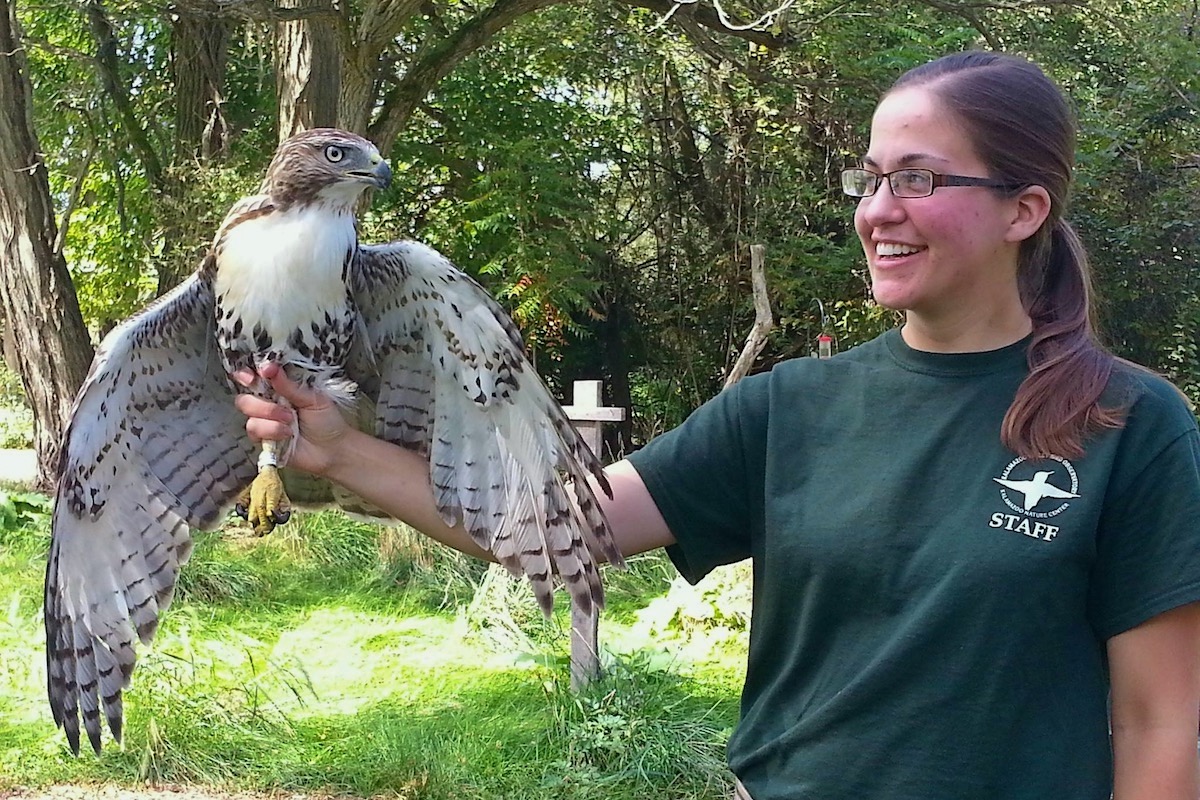
Holding a banded red-tailed hawk Hurd removed from a mist net at Kalamazoo Valley Bird Observatory.



Holding a banded red-tailed hawk Hurd removed from a mist net at Kalamazoo Valley Bird Observatory.
Photos courtesy of Maureen Hurd.
Maureen Hurd has been captivated by birds and other wildlife her entire life. As a child, she developed a fascination for hummingbirds through her grandmothers, both of whom were avid birdwatchers. Growing up in the country in western Michigan, one of Hurd’s chores was mowing the lawn. She enjoyed watching barn swallows circle overhead, feeding on insects kicked up by the mower. Discovery of a barn swallow nest under the porch led to more nest searching, which inspired her to seek a career in wildlife biology and management.
While a student at Grand Valley State University in Allendale, Michigan, where she earned her bachelor’s degree, Hurd volunteered to work on a nest box monitoring project. Working with tiny tree swallow nestlings, she watched them fledge and saw the crazy aerial acrobatics of feeding adults.

“I was hooked on field research and couldn’t believe there were career opportunities such as this,” Hurd explained, noting that her advisor recommended she further explore her interest in birds through some temporary research assignments. Her first venture took her to Arizona where for three months she was a member of a University of Montana team searching for and monitoring nests of passerines as part of a long-term research project. She also worked at Fort Drum, New York as a team member of a Cornell Lab of Ornithology study on the genetics of golden-winged and blue-winged warblers, and in North Dakota tracking grassland birds with radio telemetry.
Hurd considers her internship at a migratory bird banding station, Kalamazoo Valley Bird Observatory, her favorite experience.
“I was able to band around 700 birds, and seeing them up close was an incredible experience,” she remarked. “My desire to pursue a career with wildlife was sealed during my experiences as a wildlife technician—I met several inspiring scientists who encouraged me to reach for my dream.”
While in graduate school at the University of Illinois Urbana-Champaign, where she studied two aerial insectivores, the chimney swift and common nighthawk, Hurd accepted a position with the Illinois Department of Natural Resources (IDNR) Natural Heritage Graduate Student Residency Program.
Hurd credits the one-year residency program with providing her “the opportunity to work with a number of natural resource professionals to gain applied and on-the-ground experiences such as prescribed burning and invasive species control. Shadowing District Heritage Biologist Eric Smith for the year, I witnessed the impact that biologists and land managers are having on the landscape. But I also saw how much more work is needed and I wanted to be a part of the team making that happen.”
That revelation inspired Hurd to seek out opportunities to work in the natural resource management field. Her aspirations were fulfilled in April 2020 when she accepted a position as an IDNR District Wildlife Biologist. Her district covers the counties of Henderson, Mercer, Warren, Knox and Peoria.
Despite limitations on activities due to the COVID-19 restrictions, Hurd was able to participate in the modified annual goose banding effort as well as dove and wood duck banding programs.

“I have greatly enjoyed the wildlife population monitoring efforts that are part of my job as they provide me with a clear reminder of why I am passionate about natural resource management,” she explained. “I also enjoyed the public interaction that comes with guiding homeowners through the resolution of nuisance wildlife problems, and my time working with hunters on the Mississippi River as I have been inspecting waterfowl blinds.”
Hurd is excited about her work with IDNR Site Superintendents to expand hunting opportunities in her District.
“Henderson Creek State Fish and Wildlife Area, a bottomland area adjacent to the Mississippi River near Oquawka, is showing promise for more hunting opportunities in the future as we consider plans for improving the wetland habitat,” she remarked. “In Knox County, we would like to offer more upland hunting opportunities at Snakeden Hollow State Fish and Wildlife Area, a 2,500-acre site primarily managed for goose hunting.”
Hurd is thankful for the career advice her college advisor offered: don’t jump into just anything but keep exploring, find where your passions lie and then go with it.
For Maureen Hurd, a passion that started with hummingbirds and barn swallows has taken her around the country and into a satisfying career in wildlife management.
Kathy Andrews Wright retired from the Illinois Department of Natural Resources where she was editor of OutdoorIllinois magazine. She is currently the editor of OutdoorIllinois Journal.
Submit a question for the author
Question: I work for the Village Of Alexis, I am emailing to request a permit to trap nuisance skunks throughout the Village. What are the steps that I need to do in order to acquire this permit. Thank you.